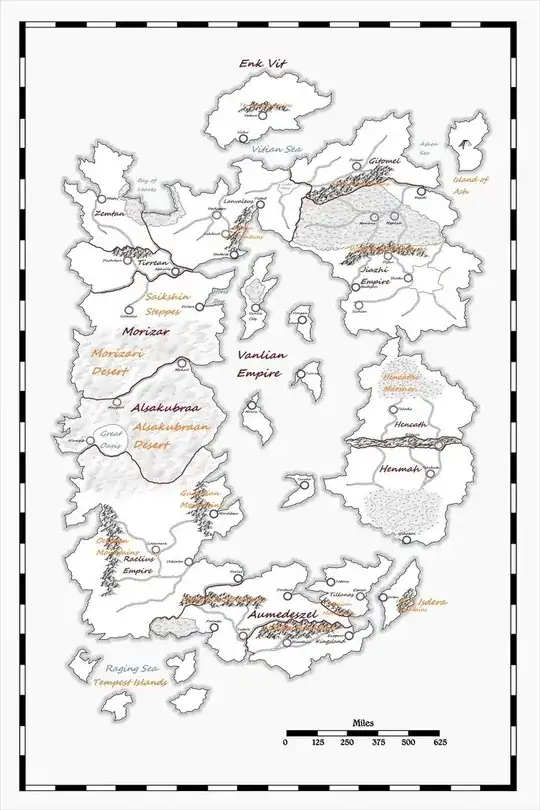First off the bat, I see three obvious problems.
You've got a desert, or at least a very arid zone, which occupies the entire width, from shore to shore, of a long continent with ocean on either side. What are the coastlines like?
Why is it so arid? We'd usually have lack of water for a combination of two reasons: no rain or no soil. Mountains or altitude can prevent rain from reaching an arid zone, but we have no mountains here. Let's look at the rivers.
You have one that seems to come from an upwelling and flow west for a short distance. It apparently doesn't irrigate much of the surrounding land, so I'd suppose that it sits in the middle of a basin. You have another river that flows east for a longer distance. Rivers can often be quite limited in the fertile area that they feed — e.g. the Nile in Egypt, — so that works well enough in that regard. This one seems to have a subterranean source, too, since it is in the middle of a land that sees no precipitation to feed it.
¶
What you have there is a large arid region apparently sitting at a high altitude on a plateau of land which can't hold water above the bedrock, and which is sitting atop a large aquifer (i.e. lots of water between the granules of rocks underground). But, it doesn't really look like that when you examine the coasts. Besides, what would keep the aquifer held together so far above sea level?
You have a isolated range of mountains, the “Desmonles” or something like, which does not seem to follow the contours of the surrounding landmass. Is there a reason for it to be so straight?
Your two big marshes look a little ill-situated. Like they don't actually come from the rivers, but were simply stamped down at their mouths.
Maybe the rivers meet huge basins that get flooded — but 120 miles away from the river seems rather far.
Those were the things which I noticed first. Other answers have mentioned some of the other problems, especially with the rivers — like that one apparently inland sea or something in the northeast, — so I will not rehash them here.
I will say that you need to give some indication of both latitude and compass directions. Never mind the terrain itself, but if you expect people to see this map as a small part of a larger globe much like the Earth, they need some points of reference. Otherwise, you'll end up with people either presuming that it is equatorial, at their own native latitude, or in some flat fantasy world with a single, and probably temperate, climate over the entire thing.
Okay, enough about that. All in all, don't take my comments too harshly or too seriously. I was going for frankness in my assessments.
As for the large bland patches, remember that there are probably lots of hills, forests, springs, farms, and waterways in those places — they simply weren't large or dense enough to register on your map.
The large land of Morizar and Alsakubraa, for example, is comparable in size to places like the Arab peninsula or Ontario. The entire map would fit nicely inside Australia, and the habitable land surface area could almost snuggle together in the Outback.
The sparseness, the mountain contours, and the incompatible climates.
How would one address those concerns with their world?
I begin by drawing lines of longitude across my map. That will give you some idea of the seasonal climates in the areas. Then I can draw tectonic plates. Continental shelves go atop those. Coastlines and shallow seas and mountains come next.
Mountains usually go on the edges between the plates. In the middle of a plate, they are often caused by volcanism.
Drawing isoclinic contour lines, beginning at the coastlines and working inland, is the next step. Indeed, you already began at coastlines and mountains. Now, you need to fill in the lands between.
Another thing that helps is to work with smaller strokes. You have two large marshes, one giant aridland, and a one large jungle or something. Try to have a few smaller areas rather than those big clumps.
On the whole, a lot of fantasy maps are really just straight–up garbage — even published and selling, — so you are doing well enough. Why are some maps so bad? Because their designers didn't take them seriously. The problem is never one of how realistic your maps are, but how much you are willing to make them real.
